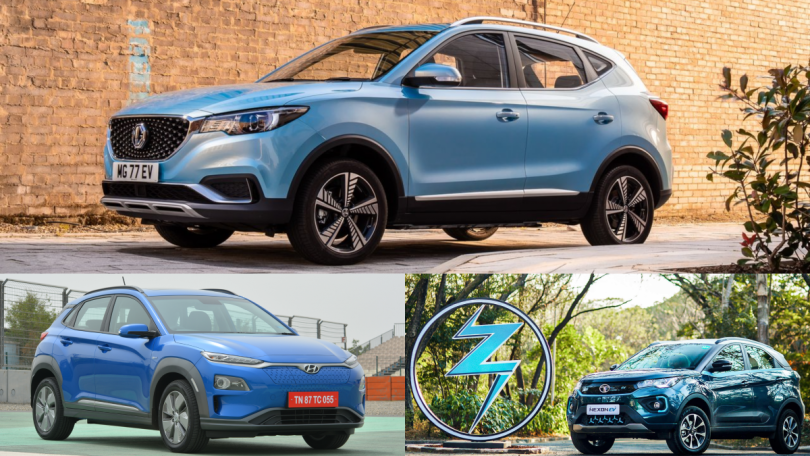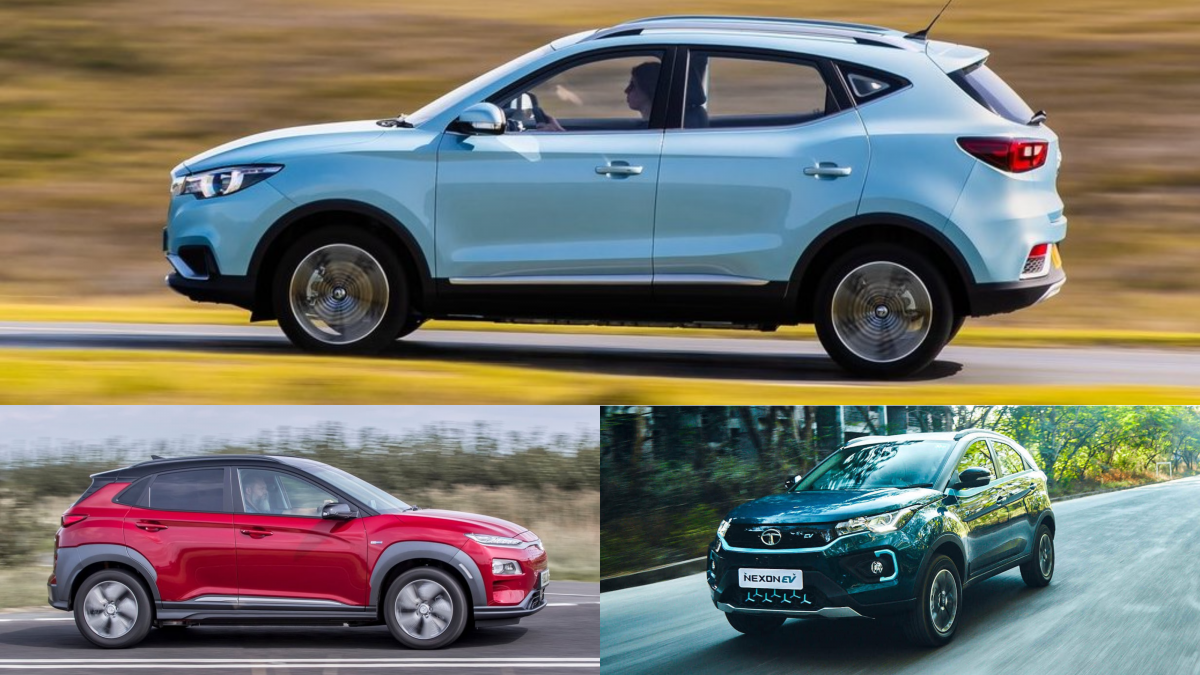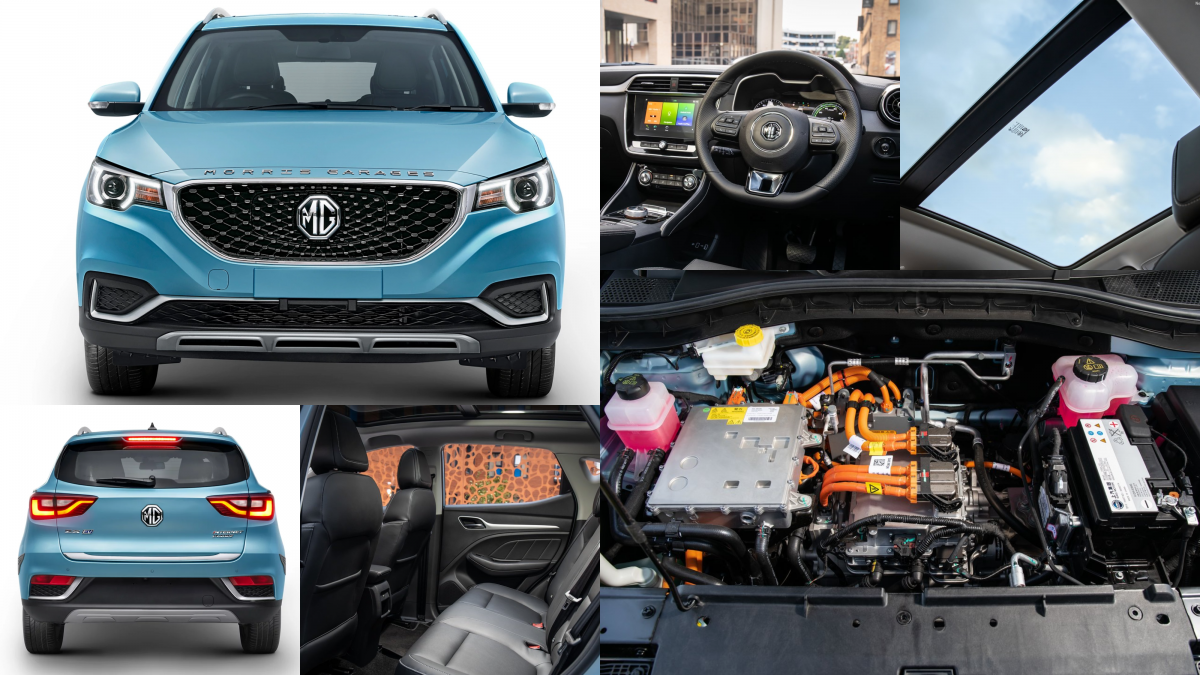They say the future of automobiles is electric. Fine. But what about the present? What if you wish to bring home an EV now and want your car’s body style to be an SUV? If you’re in this dilemma, then this post shall help you make an informed buying decision. Should you plan to book an all-electric, battery-operated SUV here in India, you have three good options in the 5-seater segment. At the lower end of the spectrum, you have Tata’s Nexon EV, then comes MG Motor India’s ZS EV and lastly, the Hyundai Kona Electric. So, which one of these suits you best?
Specifications:
| MG ZS EV | Hyundai Kona | Tata Nexon EV | |
| Price | INR 20.99 – 24.18 lakh | INR 23.77 lakh | INR 13.99 – 16.40 lakh |
| Length | 4314 mm | 4180 mm | 3993 mm |
| Width | 1809 mm | 1800 mm | 1811 mm |
| Height | 1620 mm | 1570 mm | 1606 mm |
| Wheelbase | 2585 mm | 2600 mm | 2498 mm |
| Ground Clearance | 177 mm | 172 mm | 205 mm |
| Battery Capacity | 44.5 kWh | 39.2 kWh | 30.2 kWh |
| Range | 419 km | 452 km | 312 km |
| Max Power | 142.76 PS | 136 PS | 129 PS |
| Max Torque | 353 Nm | 394.91 Nm | 245 Nm |
| 0-100 kmph | 8.5 sec | 9.7 sec | 9.9 sec |
| AC Charge Time | 6 – 8 H | 6 H 10 Min | 8.5 H |
| DC Charge Time (0-80%) | 50 Min | 57 Min | 60 Min |
Price:
First, let’s get the most important question out of our minds. Among these 3 EVs, the cheapest model out there is the Nexon EV starting at INR 13.99 lakh. This is followed by the MG ZS EV starting at INR 20.99 lakh and then comes the Kona at INR 23.77 lakh. So in order of affordability, this is it. But is cheapest always the best bet? Is the most expensive model out there always the best? To each his own, but we have a few more points to help you understand these cars better.
Size and looks matter:
In this comparison, the Tata Nexon EV is a sub-4 metre compact-SUV. The other two electric vehicles slot in a segment above. So the ZS EV is the longest & tallest, while the Kona has the most extended wheelbase and the Nexon EV being the widest. In terms of ground clearance, the least is the Kona Electric’s at 172 mm, then comes the ZS EV at 177 mm and the Nexon EV standing tall at 205 mm.
But these are just numbers. In terms of outright space, the Tata Nexon EV does fall short. This is because it is a smaller car in every way. If cabin space is what you need, then the MG ZS EV is the most comfortable cabin of the three. The Hyundai Kona, though, has a longer wheelbase. At least two passengers in the back seat will be the happiest in the ZS EV, if not three.
The ZS EV offers a more typical SUV appearance in terms of design. While the Kona looks more like a hatchback crossover. The Tata Nexon, on the other hand, is the funkiest with a lot of colour play. This can certainly be a little overkill for some customers. But then, looks are subjective, so we will let you think which one suits your personality better.
Battery Capacity & Range:
The electric SUV in this comparison with the largest battery capacity is the MG ZS EV. It comes with a 44.5 kWh hi-tech battery pack coupled to a 3 phase permanent magnet synchronous motor. The ZS EV pumps out the highest power output at 142.76 PS. This allows the SUV to sprint from 0-100 kmph in 8.5 seconds. The time is well over a second faster than the other two. On a full charge, the MG ZS EV can offer you a driving range of 419 kilometres. This range has been recently bumped up with the 2021 update.
Hyundai’s Kona Electric has the highest range of 452 kilometres among the three SUVs in consideration here. The Kona Electric comes with a 39.2 kWh battery pack which belts out 136 PS of power and 394.91 Nm of torque. So, the Kona is delivering the best torque output of the three. But still, the Hyundai EV sprints from 0-100 kmph in 9.7 seconds. This is a full 1.2 seconds slower than the MG ZS EV.
Lastly, you have the affordable Tata Nexon EV, which runs with a 30.2 kWh battery pack producing 129 PS of power, 245 Nm of torque and sprinting from 0-100 kmph in 9.9 seconds which is 1.4 seconds slower than the MG ZS EV. Tata claims that on a full charge, the Nexon EV can deliver a range of 312 kilometres.
Charging Time:
You’re not buying an EV to drive ‘Fast & Furious’ all the time, are you? Let’s consider you are pressed for time, and you want to know which of these three will give you a quick 0-80% top-up en route on your road trip. If you’re going to park it overnight and leave it on charge, why even bother about the time it takes with the AC charger. So, should you charge these cars on a DC fast charger, from 0-80%, the ZS EV will take 50 minutes, the Kona Electric will take 57 minutes and the Nexon EV will take around 60 minutes.
Ride Quality:
Try all of these electric SUVs back to back, and each of them has its strong points. The MG ZS EV offers a very cushiony ride quality, which all will appreciate in the family. With ample space on offer, it turns out to be the ideal family electric SUV in this comparison. Suppose you want something on the sporty side of the scale, the Hyundai Kona Electric, with its firm suspension setup, darts around corners, giving you plenty of confidence. On the other hand, the Tata Nexon EV has more than enough ground clearance on offer, so you don’t have to worry about seriously hurting the battery pack when driving over typical Indian road conditions.
Each of these cars has a battery pack coupled to the floor in the wheelbase section. This gives them a good centre of gravity, and overall body roll is well controlled in all of them. Cabin comfort on the move is the best in the ZS EV, followed by the Nexon EV, and the Kona Electric scores the least thanks to its tighter cabin and a firm ride.
Features:
Among the three, the ZS EV has the most prominent panoramic sunroof, which covers 90% of the roof area when compared to the conventional units of the Kona Electric and Nexon EV. The MG ZS EV also gets a unique PM 2.5 cabin air filter to improve the AQI to 30 within 5 minutes. The Tata Motors ZConect App (powered by iRA) on the Nexon EV does offer connected car features. But the i-SMART 2.0 system of the MG feels better incorporated. Even the touchscreen infotainment of the ZS EV feels better to use, and the display is better too. With 100+ voice commands, range alert en route to a preset location and Gaana premium account for entertainment; MG indeed has the edge over the other two cars in this comparison.
Warranty:
Tata’s Nexon EV comes with a battery pack warranty of 8 years / 1,60,000 kilometres. The EV warranty is 3 years / 1,25,000 kilometers. Hyundai’s Kona Electric also has the same 8 years / 1.6 lakh kilometres warranty on the battery pack, while the EV comes with the brands wonder warranty of 3 years / unlimited kilometres or 4 years / 60,000 kilometres or 5 years / 50,000 kilometres. The ZS EV with the MG eShield comes with a 5 year free-of-charge warranty for unlimited kilometres on the car and 8 years / 1.5 lakh kilometres warranty on the battery pack. MG also offers RSA for 5 years for free, along with 5 labour-free services to the customer.
Problems:
All three cars in consideration here have spent more than a year on the Indian streets. That’s good enough to let out a good or bad word of mouth. Over the past few months, a lot has been said about the Tata Nexon EV over the claimed range to the extent that the Delhi High Court had to intervene. On the other hand, Hyundai Kona Electric worldwide has faced heat over battery issues and potential fire risk. Hyundai even recalled the Kona here in India. All this while, the MG ZS EV has had a relatively easy way out on the streets and found new buyers.
Verdict:
Suppose you’re buying an electric vehicle today. In that case, we are sure your primary objective is commuting within the city, or not more than 100-150 kilometres one-way, thanks to our country’s EV infrastructure. So if you want an all-rounder, we would suggest you pick the MG ZS EV. Yes, it is not the cheapest, but it is comfortable, it is fast, loaded with features and has a decent range not to make you anxious.






